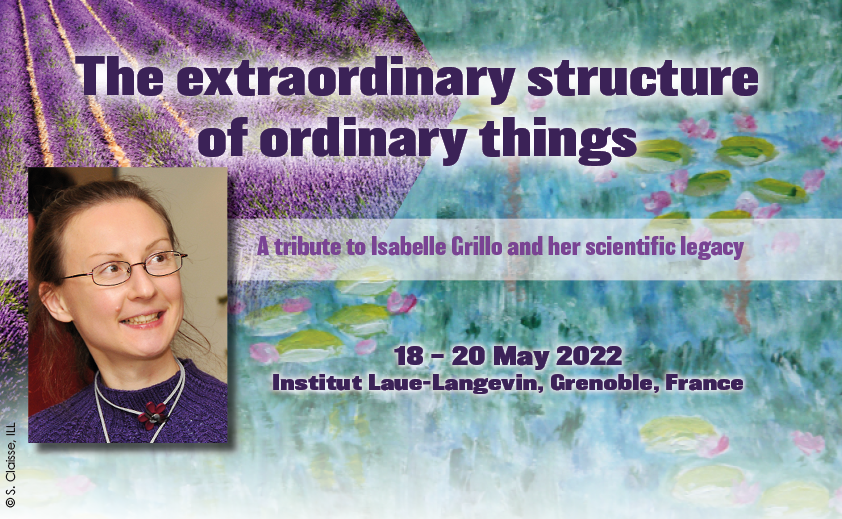Speaker
Description
In memory of Isabelle, I choose 4 projects realized with her to illustrate how SANS can be used to determine the structure and the kinetic evolution of self-assembled nanostructured hybrid materials. In mesostructured materials made of organic surfactant (CTAB) and inorganic materials (ZrO2), SANS kinetic experiments (with a stopped-flow coupled to SANS) permitted to identify the role played by the micelles in the precipitation process.[1] In the nanoparticle field, SANS also appears as a technique of choice to characterize the 3.2 nm CTAB bilayer around gold nanorods.[2] Probing the organic part of hybrid materials helps to understand the structure and mechanisms of formation of nanomaterials.
For the case of self-assembling squalene based nanoparticles used for nanomedecine,[3] SANS revealed 1) that particles size is controlled by the solvent composition (ethanol-water) after nanoprecipitation process[4] and 2) the key role of the organic solvent used in the nanoprecipitation process of nanoparticles formulation.[5] For squalene-adenosine (SqAd)[6] and Sq-SiRNA PM22 bioconjugates,[7] SANS coupled with different technics (Cryo-TEM, circular dichroism, steady-state fluorescence spectroscopy and isothermal titration calorimetry) helps to identify the specific interaction between the nanoparticles and fetal bovine serum (FBS) or bovine serum albumin (BSA), the main protein of blood plasma. The SqAd nanoparticles disassembles with the formation of complex between BSA and SqAd monomers extracted from the nanoparticles.[8] The Sq-SiRNA nanoparticles exhibit a colloidal stability in the presence of BSA or LDL which could be related to their particular structure.[9]
In each of these examples, SANS is a key technique to probe the transformation of the organic part in self-assembling nanostructured hybrid materials, allowing an access to the mechanisms of formation, disassembly and activity.
- Né, F., Testard, F., Zemb, Th., Grillo, I., “How does ZrO2/surfactant mesophase nucleate? formation mechanism” . Langmuir (2003), 19, 8503-8510.
- Gomez-Grana, S., Hubert, F., Testard, F., Guerrero-Martinez, A., Grillo, I., Liz-Marzan, L.M., Spalla, O. “Surfactant (bi)layer on Gold Nanorods” Langmuir (2012), 28, 1453-1459.
- Desmaële, D., Gref, R., & Couvreur, P. (2012). « Squalenoylation: a generic platform for nanoparticular drug delivery”. Journal of controlled release (2012), 161(2), 609-618.
- Saha, D., Testard, F., Grillo, I., Zouhiri, F., Desmaele, D., Radulescu, A., Desert, S., Brulet, A., Couvreur, P., Spalla, O. “The role of solvent swelling in the self-assembly of squalene based nanomedicines” Soft Matter (2015), 1, 4173-4179.
- Elodie Marret, “Nanoprecipitation de dérivés squalénés en milieu aqueux : Influence de la formulation sur la distribution de taille et structure interne des nanoparticules obtenues », thèse soutenue à l’Université ParisSaclay, (2019).
- Gaudin, A., Yemisci, M., Eroglu, H., Lepetre-Mouelhi, S., Turkoglu, O. F., Dönmez-Demir, B., Caban, S., Sargon, M. F., Garcia-Argote, S., Pieters, G., et al. “Squalenoyl Adenosine Nanoparticles Provide Neuroprotection after Stroke and Spinal Cord Injury” Nat. Nanotechnol. (2014), 9, (12), 1054–1062.
- Boutary, S., Caillaud, M., El Madani, M., Vallat, J. M., Loisel-Duwattez, J., Rouyer, A., ... & Massaad-Massade, L. (2021). “Squalenoyl siRNA PMP22 nanoparticles are effective in treating mouse models of Charcot-MarieTooth disease type 1 A ». Communications biology (2021), 4(1), 1-14.
- Gobeaux, F., Bizeau, J., Samson, F., Marichal, L., Grillo, I., Wien, F., Yesylevsky, S. O., Ramseyer, C., Rouquette, M., Lepêtre-Mouelhi, S., Desmaële, D., Couvreur, P., Guenoun, P., Renault, J-P., Testard, F. “Albumindriven disassembly of lipidic nanoparticles: the specific case of the squaleneadenosine nanodrug” Nanoscale (2020), 12, 2793-2809.
- Caillaud, M., Gobeaux, F., Hémadi, M., Boutary, S., Guenoun, P., Desmaële, D., Couvreur P., Wien, F. Testard, F, Massaad-Massade, L. (2021). “Supramolecular organization and biological interaction of squalenoyl siRNA nanoparticles”. Int. J. Pharm. (2021), 609, 121117.

